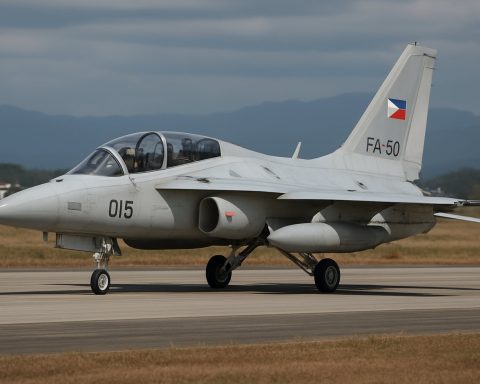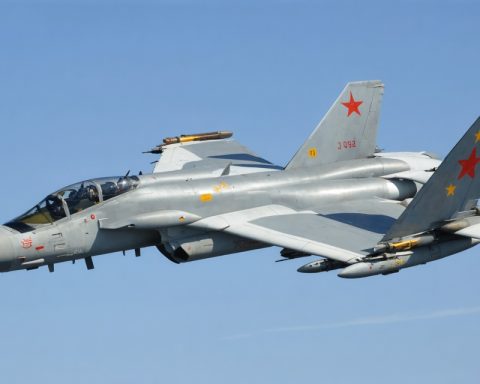- Israel’s Iron Dome system successfully intercepted three rockets from the southern Gaza Strip, demonstrating its crucial role in national defense.
- The Iron Dome’s advanced technology relies on algorithms and sensors to accurately calculate trajectories, achieving a success rate of over 90%.
- Developed by Rafael Advanced Defense Systems and Israel Aerospace Industries, the Iron Dome is a key component of Israel’s military strategy and civil protection.
- As communities face ongoing tensions, the Iron Dome symbolizes resilience, innovation, and a quest for peace amid conflict.
- The system not only saves lives but also emphasizes the importance of investing in life-saving technologies in a world of uncertainty.
- The Iron Dome serves as a reminder of the potential for human ingenuity to provide safety and inspire hope for future harmony.
On a tense Saturday afternoon, Israel’s Iron Dome defense system stood vigilant, intercepting three rockets launched from the southern Gaza Strip. As sirens blared across the Nir Yitzhak, Sufa, and Holit regions, signaling impending danger, the advanced weaponry of the Iron Dome swiftly turned potential disaster into a testament of technological prowess.
The scene in southern Israel was fraught with urgency. Families rushed to secure shelters as the sky ripped open with alarms. Yet, amid this precarious atmosphere, the Iron Dome once again showcased its unparalleled precision. Through a symphony of algorithms and sensors, it calculated trajectories with astounding accuracy, guiding interceptor missiles to obliterate their targets mid-air.
This defensive marvel, developed by Rafael Advanced Defense Systems and Israel Aerospace Industries, is a keystone in Israel’s military strategy. With each interception, it preserves lives and fortifies a national sense of security. The Iron Dome’s success rate, soaring above 90%, is not just a statistical triumph—it represents layers of meticulous engineering and relentless innovation aimed at protecting civilian life.
As tensions flare and communities grapple with the psychological weight of conflict, the Iron Dome becomes a beacon of hope, seamlessly integrating human ingenuity with cutting-edge technology. It offers not just a shield against physical threats, but also a reminder of resilience and the urgent quest for peace amid recurring discord.
While military engagements in the region evoke complex diplomatic challenges, the offering of security through the Iron Dome points to a broader narrative: that in a world fraught with uncertainty, investing in life-saving technology is an imperative. Through its silent insistence on safety, the Iron Dome voices a clear imperative—a collective yearning for peace and a future unmarred by the shadows of conflict.
Inside the Iron Dome: How Cutting-Edge Technology Protects Lives in Turbulent Times
The Advanced Capabilities of the Iron Dome
The Iron Dome is not just a symbol of protection in Israel but also a marvel of modern engineering and military technology. This system boasts the ability to intercept and destroy short-range rockets and artillery shells fired from distances of 4 to 70 kilometers away, making it an essential component of Israel’s defense infrastructure. Each battery consists of a radar unit, a control center, and up to three launchers, each equipped with 20 interceptor missiles.
How the Iron Dome Works
1. Detection and Tracking: The system’s radar detects incoming rockets and tracks their trajectory.
2. Threat Assessment: Using advanced algorithms, the control center assesses which rockets pose a threat to populated areas.
3. Interception: Interceptor missiles are launched towards threats deemed dangerous, destroying them mid-air.
Real-World Applications and Insights
The Broader Impact
– Psychological Security: Beyond physical protection, the Iron Dome provides psychological relief to residents, reducing panic and allowing for a semblance of normalcy.
– Political Leverage: The system strengthens Israel’s negotiating power in conflict situations, offering a defensive backbone that complements diplomatic efforts.
The Economics of Defense
Maintaining and operating the Iron Dome is costly, with each interception costing between $40,000 and $100,000. Despite the expenses, the investment is justified by the system’s ability to save lives and prevent costly damages to infrastructure.
Pros and Cons Overview
Pros:
– High success rate of over 90%.
– Mobile units can be deployed rapidly based on threat levels.
– Offers a psychological sense of safety to populations under threat.
Cons:
– High operational costs per interception.
– Limited range and effectiveness in urban environments with densely populated areas.
– Potential overspending on technology without addressing underlying conflict causes.
Future Developments and Predictions
Industry experts predict that future iterations of the Iron Dome may integrate more advanced AI systems to enhance precision and reduce costs. Additionally, collaboration with allies like the United States could lead to greater deployment of these systems internationally, especially in regions facing similar threats.
Actionable Recommendations
– For Residents: Stay informed about the nearest shelters and understand how to respond during an alarm.
– For Policy Makers: Invest in complementary technologies and pursue diplomatic efforts to reduce frequency of threats.
– For Global Allies: Collaborate on security technologies to bolster mutual protection capabilities.
Conclusion: The Urgency of Peace
While the Iron Dome demonstrates a triumph of technology in safeguarding lives, it underscores a larger truth: the need for sustainable peace. Technological defenses, while crucial, should go hand-in-hand with renewed efforts for diplomatic resolutions to underlying conflicts in the region. This dual approach ensures not just immediate security, but long-term tranquility.
Explore more about innovative defense solutions at Rafael Advanced Defense Systems and Israel Aerospace Industries.











